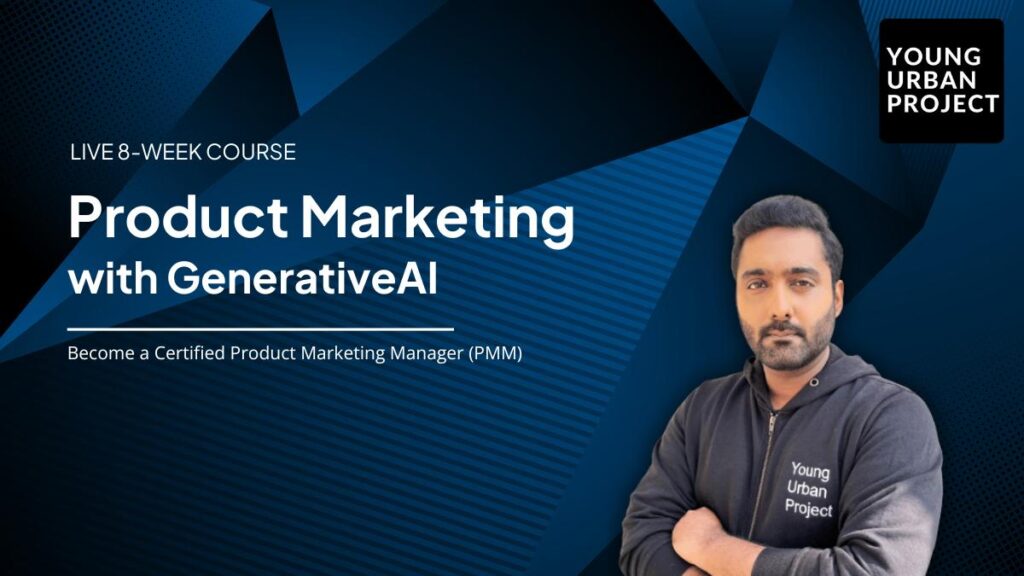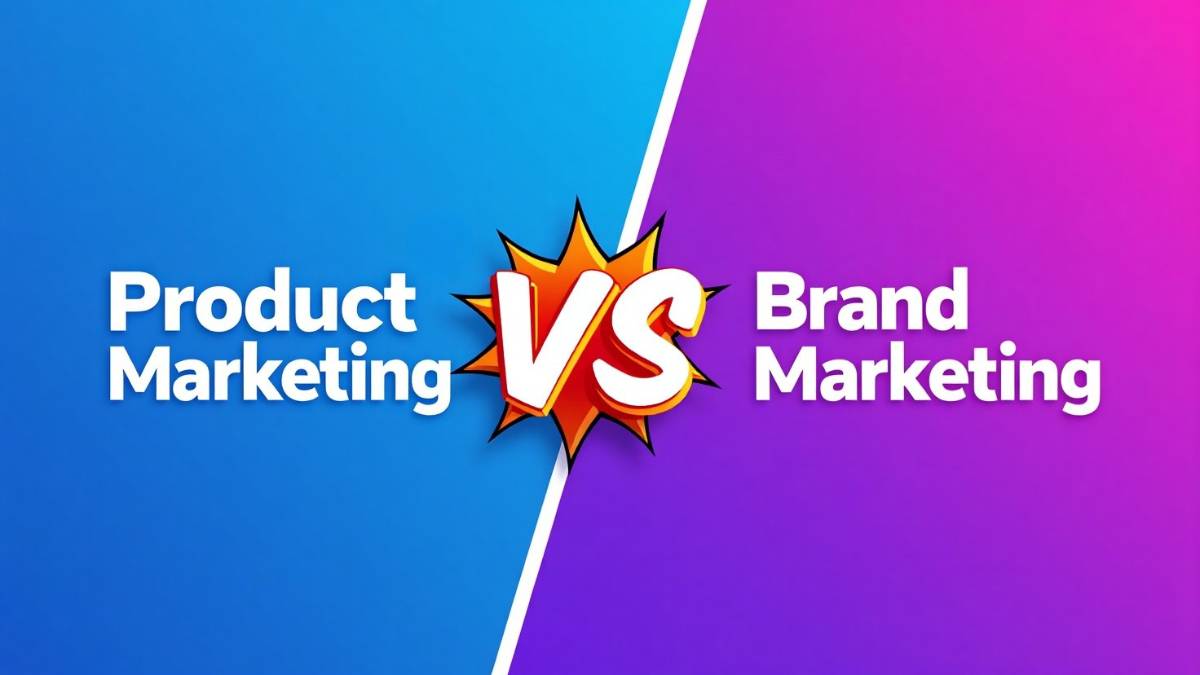If you’ve been diving into marketing strategy, you’ve probably come across the terms product marketing and brand marketing. They often get used interchangeably, but in reality, they play very different roles in growing a business.
So, why does it matter to know the difference?
Simple. If you don’t understand how these two work separately and together, you might waste your marketing budget, miss key growth opportunities, or worse, confuse your audience.
Think about Apple for a second. When they launch a new iPhone, that’s product marketing in action. But when you see their iconic “Think Different” campaigns? That’s brand marketing working its magic. Different goals. Different strategies. Same company.
Let’s break down Product Marketing vs Brand Marketing in detail.
Table of Contents
What is Product Marketing?
Alright, let’s start with the easier one to grasp: product marketing.
Product marketing is all about bringing a product to market and making sure the right people want it, understand it, and eventually buy it.
It’s the link between product development and customer demand.
If you’ve ever seen a product demo video, downloaded a feature comparison sheet, or read launch emails about a new feature, that’s product marketing at play.
Where does it sit in the marketing world? Right in the middle of:
- Product teams (what should we build?)
- Marketing teams (how do we tell people?)
- Sales teams (how do we close the deal?)
- Customer success (how do we keep them happy?)
It’s tactical. Focused. And often directly tied to revenue goals.
Also Read: What is a Product Marketing Framework?
Key Objectives of Product Marketing
Here’s where product marketing really earns its keep:
1. Launching New Products Successfully
No product launch happens by accident. Product marketers plan Go-To-Market (GTM) strategies with military precision.
2. Positioning & Messaging for Product-Market Fit
Without the right messaging, even the best product can flop. Product marketers work to answer:
- Who’s this for?
- Why should they care?
- How’s this better than what’s already out there?
3. Driving Product Adoption & Revenue Growth
Good product marketing doesn’t stop at launch. It helps customers use the product properly, meaning more value for them, and more revenue for the business.
4. Supporting Sales Teams with Enablement Materials
Think sales decks, comparison charts, objection-handling guides, all created by product marketing to make the sales team’s life easier.
5. Conducting Product-Centric Market Research
What features do customers actually want? What are competitors offering? Product marketers dig into this constantly.
Also Read: Product Marketing Strategies and Examples
Core Strategies & Tactics in Product Marketing
So, how does product marketing actually get done? Here’s the real-world playbook, no fluff, just the good stuff:
1. Customer Persona & Segmentation
First, you’ve gotta know who you’re selling to. Building customer personas means writing down detailed profiles of your ideal buyers, their problems, goals, quirks, all of it. Once you know them, you can group them (segment them) and target your messaging way better.
2. Crafting Unique Value Propositions (UVPs)
What makes your product special? That’s your UVP. It should be short, clear, and focused on benefits, not just features. Example: Slack’s, “Be more productive at work with fewer emails.” It’s not about software, it’s about solving an everyday frustration.
3. Product Positioning & Messaging Frameworks
Positioning is about where you fit in the market. Messaging is about what you say to sell that story. It’s how you connect your product to what people actually care about. Tools like StoryBrand help make sure it’s not just words, it’s a story people remember.
4. Go-To-Market (GTM) Strategy
This is your launch game plan. GTM tells you what to say, where to say it, and who to say it to. It covers marketing, sales, content, timelines, everything. Think of it like the master plan before the product hits the shelves or the homepage.
5. Product Launch Plans
Good launches build hype. It’s not just “here’s our product”, it’s teaser emails, sneak peeks, beta invites, influencer buzz, maybe even events or PR drops. Tesla’s Cybertruck launch was weird but brilliant, they made headlines before a single unit was sold.
6. Demo Creation, Feature Videos, Tutorials
Show, don’t just tell. People need to see how your product works to get excited about it. Videos, walkthroughs, how-to tutorials, they make abstract features feel real. Especially important for SaaS and tech products that sound complicated on paper but are easy once you see them.
7. Pricing Strategies & Tiering Models
Pricing’s a marketing tool, not just a finance decision. Do you offer a free trial? Should small teams pay less? Should big enterprises get custom quotes? Smart pricing can drive growth. Mess it up, and you’ll scare away people who would’ve bought otherwise.
8. Feedback Loops for Continuous Improvement
After launch, the work’s not over. Real users will tell you what’s working, and what’s annoying. Feedback should loop right back into marketing and product. Fix the rough edges. Add the features people ask for. That’s how good products turn into great ones.
Also Read: How to Become a Successful Product Marketing Manager
What is Brand Marketing?
Now, let’s zoom out a bit.
Brand marketing is the art and science of shaping how people feel about your business.
It’s not about selling individual products. It’s about building emotional connections with your audience, the kind that makes someone buy from you again even if your competitor is cheaper or faster.
Where product marketing drives short-term wins, brand marketing builds the foundation for long-term success.
When people say, “That brand just gets me,” that’s great brand marketing in action.
It’s why you trust Nike when they say “Just Do It”, even though hundreds of other companies make running shoes.
Key Objectives of Brand Marketing
Here’s what brand marketers focus on:
1. Building Brand Awareness and Recognition
If people don’t know your brand exists, nothing else matters. Brand marketing solves that.
2. Creating Emotional Brand Connections
People don’t just want products, they want stories, values, and belonging. Brand marketing builds those bridges.
3. Differentiating in Crowded Markets
Even if your product is similar to others, a strong brand can make you stand out. Just ask Coca-Cola in the soda world.
4. Enhancing Brand Loyalty and Advocacy
It’s not just about getting customers. It’s about keeping them, and turning them into raving fans.
5. Influencing Purchase Decisions Beyond Features
Ever bought something just because you liked the brand? That’s the power of brand marketing at work.
Core Strategies & Tactics in Brand Marketing
1. Defining Brand Purpose, Mission & Vision
Your brand needs a reason to exist beyond making money. Purpose drives loyalty. Mission defines what you’re doing now, vision shows where you’re going. Example: Patagonia’s mission, “We’re in business to save our home planet.” That clarity attracts passionate, values-driven customers.
2. Visual Identity: Logo, Colors, Typography
People remember what they see first. Your logo, color palette, and fonts are signals of who you are. Great visual identity builds trust before a single word is spoken. Think of McDonald’s golden arches or Coca-Cola’s red, instant recognition, no explanation needed.
3. Brand Storytelling and Consistency Across Channels
A great brand doesn’t change its personality depending on where it’s talking. Website, Instagram, ads, emails, same story, same vibe, every time. Your messaging should be unmistakable. Example: Airbnb’s story of belonging anywhere appears across everything they publish.
Also Read: 11 Great Product Marketing Examples
4. Emotional Branding
Products solve problems, but brands create feelings. Emotional branding taps into what your audience wants to feel, empowered, inspired, connected. That’s why Nike’s “Find Your Greatness” campaign resonated so deeply, it wasn’t about shoes, it was about personal ambition.
5. Thought Leadership & Content Strategy
Become the go-to expert in your space by teaching, not just selling. Blogs, podcasts, LinkedIn posts, webinars, they build credibility over time. Example: HubSpot practically owns the topic of inbound marketing because they gave away valuable knowledge for free for years.
6. Influencer & Social Media Campaigns
Collaborate with creators your audience already trusts. Influencers bridge the gap between corporate voices and real conversations. These campaigns should feel like natural endorsements, not forced promotions. Example: Glossier built a cult following by leaning heavily on influencer partnerships and user-generated content.
7. Employer Branding for Talent Attraction
Strong brands attract top talent. Why? People want to work for companies that mean something. Showcase your culture, employee stories, and workplace values. Example: Google’s playful, innovative brand doesn’t just attract customers, it draws in ambitious, creative employees who build great things.
Also Read: Product Marketing Career Path
Product Marketing vs Brand Marketing: Detailed Comparison
| Aspect | Product Marketing | Brand Marketing |
| Definition | Focuses on positioning, messaging, and promoting specific products or services to target users. | Focuses on shaping and communicating the overall brand identity to create emotional connections. |
| Primary Goal | Drive product awareness, adoption, and sales for a particular offering. | Build brand recognition, loyalty, and preference in the market for long-term growth. |
| Focus Area | What the product does, why it matters, how it’s better than alternatives. | Why the brand exists, what it stands for, how it makes customers feel. |
| Time Horizon | Short to mid-term. Centered around launches, campaigns, product cycles. | Long-term. Brand building compounds over years, not weeks. |
| Emotional vs Functional | Functional. Speaks to logical needs and tangible benefits. | Emotional. Appeals to values, aspirations, and identity of the audience. |
| Tactics Used | Positioning & Messaging – Go-To-Market Plans, Product Demos & Tutorials, Pricing Models | Brand Storytelling, Visual Identity (logo, colors, etc.), Emotional Branding Campaigns, Thought Leadership |
| KPIs (Metrics) | Product Sales, Adoption Rate, Customer Acquisition Cost (CAC), Churn/Retention | Brand Awareness, Share of Voice, Brand Recall Surveys, Brand Sentiment |
| Team Involved | Product teams, marketing, sales, and customer success closely collaborate. | Brand strategists, creative teams, PR, leadership, external partners (agencies, influencers). |
| Customer Journey Stage | Typically middle to bottom of the funnel (consideration → conversion → retention). | Primarily top of the funnel, building awareness and perception before customers even think of buying. |
| Scope | Narrow: One product → One audience → One campaign (usually). | Broad: Entire brand → Diverse audiences → Consistent across all touchpoints. |
| Relationship to Sales | Direct → Drives immediate leads and conversions. | Indirect → Creates favorable conditions for future sales. |
| Examples | Launch of the iPhone 15– Tesla’s feature demos of Autopilot or Cybertruck unveil | Apple’s “Think Different” campaign- Nike’s “Just Do It” message permeating all content |
| Success Looks Like | Revenue spike after product launch. Users loving & adopting new features | Consumers recognizing your logo instantly. Customers choosing you over cheaper competitors |
| Risks if Neglected | Great products may flop without proper messaging or positioning. | Products may sell short-term but fail to build long-term loyalty or differentiation. |
| Investment Type | Tactical → Campaign budgets, targeted ads, marketing automation. | Strategic → Brand films, big creative campaigns, sponsorships, influencer alignment. |
| Works Best When | – Launching something new – Entering new markets – Introducing new features | – Wanting to stand out in crowded markets – Seeking customer loyalty – Building legacy |

Enroll Now: Product Marketing Course
How Product Marketing & Brand Marketing Work Together
Here’s where it gets interesting: these aren’t opposing strategies, they’re teammates.
If product marketing is the engine, brand marketing is the fuel.
Let’s take Apple again (because, honestly, they’re one of the best at this). Their product marketing for iPhones focuses on tangible features like camera tech or performance boosts. Meanwhile, their brand marketing reminds you that buying Apple means being part of something “different,” innovative, cool.
Or look at Nike:
- Product Marketing – “Here’s why these new running shoes help you run faster.”
- Brand Marketing – “Find Your Greatness.”
Both sides reinforce each other. Brand marketing builds long-term trust, product marketing drives short-term action. Together? Growth machine.
Also Read: Product Marketing vs Conventional Marketing
Metrics & KPIs to Measure Success
How do you know if you’re doing this right? Marketing Metrics. Let’s break it down.
For Product Marketing:
- Product Adoption Rate – Are people actually using the product after they buy it?
- Feature Usage Analytics – Which parts of the product get the most love?
- Sales Revenue per Product – Is this product making money?
For Brand Marketing:
- Brand Recall Surveys – When people think of your product category, do they think of you?
- Net Promoter Score (NPS) – Would your customers recommend you to others?
- Share of Voice / Social Sentiment – Are people talking about you online? And is it positive?
Also Read: Digital Marketing KPIs You Should Track
Common Mistakes Brands Make (And How to Avoid Them)
Let’s be honest: brands mess this up all the time. Here’s how:
1. Overinvesting in product launches but neglecting the brand
You can have the flashiest launch campaign ever, but if no one trusts your brand yet, it won’t hit as hard.
2. Focusing on “vanity branding” without product-market fit
A cool logo means nothing if your product doesn’t solve real problems.
3. Misalignment between brand voice and product messaging
Imagine a playful, fun brand, but with boring, technical product brochures. Jarring, right? Alignment is key.
Conclusion: Choosing the Right Strategy for Your Business
So which should you focus on first?
It depends. If you’re a startup launching your first product, product marketing might take the lead. But if you’re in a saturated market and need differentiation, brand marketing will help you stand out.
The real answer? Both. You don’t build a legacy brand on products alone, and you can’t sell products without some level of brand recognition. They feed each other.
Want sustainable growth? Get them working together.
FAQs: Product Marketing vs Brand Marketing
1. Which is more important: product marketing or brand marketing?
It depends on your business stage. Early-stage startups might need product marketing more urgently; established brands often lean heavier on brand marketing.
2. Can product marketing succeed without brand marketing?
Sometimes, yes, especially if you’re solving a major pain point. But long-term? A weak brand will hold you back.
3. What skills are needed for a product marketer vs brand marketer?
Product Marketer – Market research, copywriting, positioning frameworks, GTM planning.
Brand Marketer – Storytelling, emotional branding, visual design, campaign strategy.
4. How do startups prioritize between product and brand marketing?
Start with nailing your product-market fit through product marketing. Layer on brand marketing once you’re confident people want what you’re building.
5. What’s an example of a company excelling at both simultaneously?
Apple is a great example. Also: Nike. Tesla. Netflix. These brands get it right.
6. Is brand marketing more expensive than product marketing?
Often, yes. Brand marketing is a long game, think sponsorships, massive creative campaigns, influencer partnerships. Product marketing can often be done leaner, especially in early stages.

